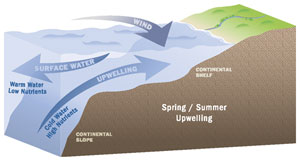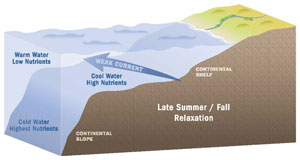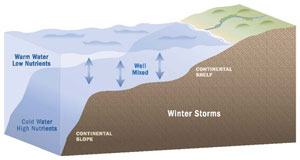Oceanographic Setting
The oceanographic year throughout the sanctuary can be separated into three oceanographic seasons. Although there is variability in when these events occur, they can generally be described as upwelling season in the spring and early summer (April - June), relaxation in the late summer and fall (July-September), and the storm season in winter (December - February)
Upwelling Season:

The Cordell Bank National Marine Sanctuary is located in one of the world’s four major coastal upwelling systems; the other three systems are located along the west coast of South America, southwest Africa, and northwest Africa. During the upwelling season (April-July), strong northwest winds and the south flowing California Current combine with the earth's rotation to drive surface waters away from the shore. These surface waters are replaced by an upwelling of nutrient-rich deeper water from offshore which spurs phytoplankton growth, which in turn supports zooplankton and higher levels of the food web. Productivity within the nearshore region is a balance between upwelling which stimulates phytoplankton growth, and mixing and movement of water further away from shore.
Relaxation Season:

The winter storm season (December to February) is dominated by rough seas and greater mixing of ocean water. Strong winter storms originating in the Gulf of Alaska cause turbulent conditions that break down stratified ocean layers in the upper water column, homogenizing temperature, salinity, and the distribution of nutrients. The northward-flowing Davidson Current has a stronger influence on circulation during this time period.
Winter Storm Season:

The winter storm season (mid-November through February) is dominated by rough seas and greater mixing of ocean water. Strong winter storms originating in the Gulf of Alaska cause turbulent conditions that mix the stratified ocean layers in the upper water column. This results in similar temperature, salinity, and concentration of nutrients throughout the water column.
For more information on oceanography within Cordell Bank Sanctuary and the research being conducted on this topic, please visit the Sanctuary Integrated Monitoring Network (SIMoN).

